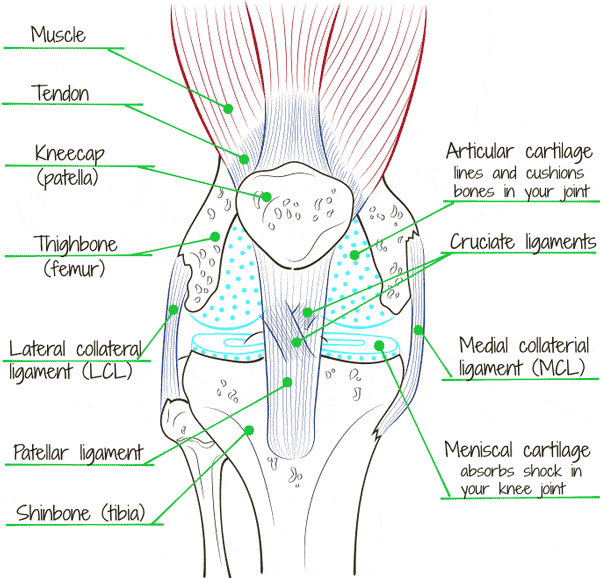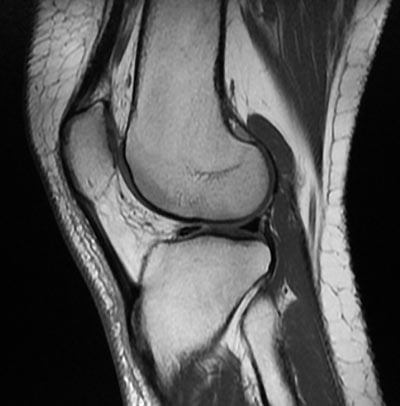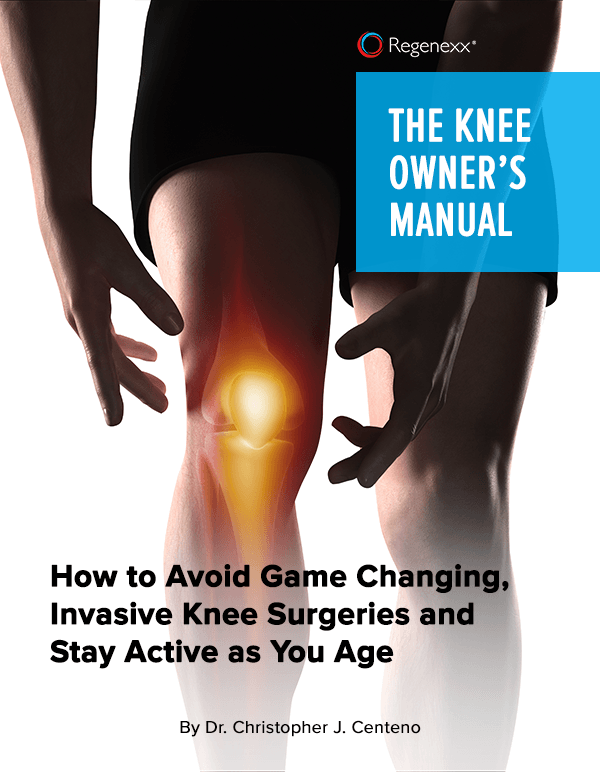Knee Pain Relief Without Surgery In Broomfield, CO
Regenerative medicine treatments may offer a superior alternative to knee surgery or knee replacement.
Regenexx Procedures are non-surgical treatments that use your body’s own healing agents to treat knee arthritis and injuries, including meniscus tears and torn ACL. Our patients benefit from reduced pain and improved function, helping them avoid surgery and knee replacement.
Are You a Regenexx Candidate?- Knee
- Meniscus
- Osteoarthritis
- ACL
The Regenexx® Alternative to Knee Surgery and Knee Replacement Surgery
The Knee Owner’s Manual
How to Avoid Game Changing, Invasive Knee Surgeries and Stay Active as You Age
Have you been told that steroid knee injections or invasive surgery are your only options to treat your knee pain? Interventional orthopedics provides a non-surgical alternative that uses your own cells to help your body heal damaged tissues and relieve pain from knee injuries and arthritis.
Recent research shows that some of the most popular orthopedic knee surgeries including meniscectomies have no benefit and are no more effective than placebo or sham surgery. Knee replacement surgery is extremely traumatic and carries associated risks. Even successful surgeries require months of painful rehab to regain strength and mobility. Sadly, most surgeries also accelerate degeneration that leads to osteoarthritis and exacerbates the problems that initially led to the need for surgery in the first place.
Regenexx urges patients suffering from knee injuries or degenerative conditions to consider all of their options. We invented a new approach to orthopedic care we call Interventional Orthopedics. This approach involves the use of image guidance (fluoroscopy and ultrasound) to precisely place high-dose cells from your body directly where they are needed in a specific joint structure. These cells then work in the site of your injury to grow into new, healthy tissue, a process that will only occur if the cells have been placed exactly where they need to go in order to achieve positive outcomes for the patient.
Regenexx procedures can help improve knee function and decrease pain without the need for surgery. During this outpatient procedure, our expert physicians use precise image guidance to inject custom concentrations of your body’s natural healing agents into the exact areas of damage to tighten and stabilize your knee joint. This precise approach to orthopedic care can’t be replicated by a surgeon or nurse in a chiropractor’s office. Regenexx specialists require thousands of hours of training and follow a standardized protocol process to become a licensed Regenexx physician.
Get back to the activities you love, without knee surgery
This has been happening off and on for months, with your knee locking alternating with giving way. You’ve been too afraid to visit the doctor because you feel too young to be faced with knee replacement or surgery that’s going to make you feel old. It happened to your parents, and you don’t want it to happen to you. And they spent a lot of money on procedures that didn’t work. Where do you turn?
We understand. We want to help you make sense of how the body works, how you’re not broken beyond repair, how to find the right help for you, and what your next steps are to getting that help.
What are the more common knee problems?
Common knee problems leading to knee pain include:
- Fracture and/or dislocation.
- Knee ligament tears.
- Cartilage wear and tear in the knee, including torn meniscus.
- Knee bursitis.
- Tendonitis and/or tendon tears in the knee.
- General knee pain caused by poorly fitting shoes, iliotibial band syndrome, hip misalignment for example.
- Osteoarthritis or degenerative joint disease in the knee.
Before we go deeper to explore potential problems in the knee, let’s look at the knee joint more closely to see how it works.
Knee joint anatomy

The knee joint is a hinge, so think of how a door opens and closes. Although, the knee has a little more flexibility to accommodate movement patterns slightly beyond the front-to-back motion of a hinge, unlike a door. The knee joint connects the femur (thigh bone) and the tibia (shin bone) and includes a protective bony cover called the patella, also known as the kneecap.
The knee can straighten (extend) to 0 degrees and can flex (bend) to about 135 degrees. Remember, it’s a hinge. In contrast, the hip and shoulder joints are ball-and-socket joints, which allow these joints to have more freedom to move in all planes of motion. You can do arm circles and move your leg at the hip front to back and side to side normally.
Many acute knee injuries occur because of an unnatural motion of the joint, forcing it into a twisting motion, a hit from one side which pushes into a side-to-side plane, or chronically poor alignment due to muscle imbalances, poorly fitting or worn-out shoes, or consistently excessive body weight.
Additionally, the knee is a weight-bearing joint. Many of the tissues in the knee joint are designed to accommodate a person’s weight and force on impact. Think of taking a step while walking versus taking a step while running. The force of those two activities are very different. There is more impact force while running. In addition, if someone’s body weight is greater than normal, there is more impact force on that person’s knee joint compared to someone of normal body weight.
Over time, the more force that the knee joint has undergone, due to excessive weight or years of repetitive excessive impact, can cause knee problems in the form of cartilage damage, chronic inflammation, and/or wear and tear. In other words, osteoarthritis or degenerative joint disease of the knee.
Therefore, pain in the knee can be caused by an acute (sudden, recent) injury or by chronic, consistent, unattended to wear and tear of the knee that hasn’t been given the space or proper environment to heal.
Parts of the knee joint:
The knee joint is made of bones, cartilage, ligaments, tendons, and sacs of fluid, all working together to keep us walking forward, jumping higher, and squatting down to pick up things from the floor.

Bones in the knee:
The bones in the knee include the femur, tibia, and patella. The femur and tibia have ends that meet called condyles. A condyle is a round prominence at the end of the bone where it meets or articulates with another bone. The medial condyle is on the inside, or middle of the knee (medial sounds like middle). The lateral condyle is on the outside.
Cartilage in the knee:
The cartilage in the knee that most people are familiar with is known as the meniscus. The meniscus is a disc of cartilage that sits between the condyles of the femur and the tibia, and it protects these ends from friction, helps distribute body weight and absorb force on impact, and protects the gliding cartilage that keeps the knee bending smoothly, so you can put your socks on.
There are actually two menisci in each knee: One medial (inside) and one lateral (outside).
In addition to meniscus tears, osteoarthritis occurs when the protective cushion of cartilage at the end your bones wears down. This is the most common type of arthritis.
Bursa sacs in the knee:
The knee contains sacs of fluid that help cushion pressure points between the bones and tendons in the knee joint and reduce friction. When you run or walk, these sacs help prevent the bones from hitting each other with every step and prevent the tendons from wearing on the bones, like rope constant wearing against a surface when pulled taut.
Ligaments in the knee:
Ligaments are thick bands of connective tissue that hold bones or cartilage together. The most familiar ligaments are the anterior cruciate ligament and the posterior cruciate ligament. Anterior means front, and posterior means back. Therefore, the anterior cruciate ligament is at the front of the knee joint, and the posterior cruciate ligament is at the back of the knee joint. These ligaments keep the tibia and femur in line with each other. Ligaments create the stability of the knee joint.
Tendons in the knee:
Tendons connect muscle to bone. The quadriceps muscle is the large thigh muscle, and it connects to the patella via the quadriceps tendon. The patellar tendon connects to the tibia. Muscles and tendons create movement in the knee joint.
Treatment Options for Knee Pain from Injury or Arthritis
What can I do to relieve knee pain from injury?
In order to relieve knee pain, we have to figure out what’s causing the knee pain. As you can see, the knee has a lot of parts that keep it protected, stable, and mobile. Any one of these can be the cause of knee pain. In addition, pain can be originating outside of the knee joint but still causing knee pain, in the case of iliotibial band (ITB) syndrome or poorly fitting or worn-out shoes.
Some knee conditions require rest and/or special exercises prescribed by a physical therapist. Yet, some require advanced medical attention simply because the pain is not being relieved or the function is not improving. Be careful about immediately accepting advice to undergo surgery. Research has shown that many of the most common surgeries, such as a “knee clean up”, are largely ineffective and unnecessary, leaving the patient in worse shape in the long term. Regenexx doctors are highly trained in diagnosing and treating knee issues non-surgically. In some cases, surgery may be the best solution.
What does arthritis pain in the knee feel like?
Arthritis literally means inflammation of a joint. Osteoarthritis is a specific type of arthritis, most frequently referred to as degenerative joint disease. While it can affect any joint, it most commonly damages knees, hands, hips, and spine.
Knee arthritis symptoms develop slowly and get worse as time goes on. The chances of developing arthritis increases after 45 years of age; however, it can affect anyone at any age. Arthritis symptoms in the knee include swelling and stiffness, as well as pain. There may be associated cracking noises as well. When you have knee arthritis, your pain may feel like weakness or “buckling” of the knee. In addition, loose fragments in the joint from cartilage or other tissues can cause the knee to lock during movement. Both of these, buckling of the knee and locking of the knee, can increase your risk of falls and acute injury to the knee.
Pain and swelling in the knee can be worse in the mornings or after sitting for long periods of time, and pain may increase during rainy or humid weather.
What can I do to relieve arthritis pain in my knee?
Relieving arthritis pain in the knee is not dissimilar from an acute injury; however, consider how much time this chronic condition has been going on. The Grand Canyon wasn’t formed in a day. It was formed by constant wear of rock by water over time.
Arthritis in the knee is caused by constant uneven, undue wear in the knee without the proper environment or space for healing.
There are pharmaceuticals to help mask the pain symptoms so that you can continue with life; however, those are fraught with side effects that can develop or worsen other medical conditions. A better approach would be to correct the uneven, undue wear and provide the proper healing environment. Unlike the Grand Canyon, the body can heal and undo some of the damage. And while it does take time, it often does take as long as it took for the chronic damage to develop.
And that’s where we come in…
Ultimately, surgery may be an option for knee arthritis pain relief, in the form of joint replacement. But cutting out and removing your knee joint shouldn’t be the first thing you try. This is a traumatic, life-altering surgery that should be avoided until it’s an absolute necessity.
Our goal is to reduce your pain by improving the healing environment of the knee joint, slowing down the progression of osteoarthritis, and improving overall knee function. By reducing the pain in arthritic knee joints, we’ve helped thousands of patients avoid or significantly delay the need for knee replacement surgery and return to their active lifestyles.
We track patient outcome data on our knee osteoarthritis treatments. Patients have reported an overall improvement of 37% after the first month and a 50% improvement at the 3-month mark. Let’s discover how the body heals and how we can help.
How does the knee joint heal?
The human body was designed to heal itself. That’s its goal. A great example is when you cut your finger. It bleeds, and then a scab forms, which stops the bleeding. Under that scab, the body sends its healing cells to the cut to seal up the wound.
Similarly, inside the body, this healing ability and function is constantly occurring. You just can’t see it. The body is constantly examining itself for signs of damage and directs its healing cells to those areas to repair them.
Some of these healing abilities are directly affected by you. In other words, you can control, to a certain extent, your body’s ability to heal. Largely within your control are the following:
- Whether or not you smoke.
- How much alcohol you drink.
- Your sleep quality and quantity.
- The amount of exercise you engage in on a regular basis.
- Nutrition and digestion: How many nutrients are becoming the cells in your body.
- Your responsiveness to stress.
These all affect your ability to heal and recover from damage due to injury and chronic damage leading to arthritis.
Even when these conditions are optimized (i.e. you don’t smoke or drink, you sleep 7 hours a night, you walk and do yoga, and eat healthy), there are circumstances when your body needs a little help to target the healing.
That’s where Regenexx Procedures can help…
What is regenerative medicine? How can regenerative medicine help my knee pain?
Today’s medicine has too many people destroying their vital tissue with medications that only mask their pain and do not contribute to healing. Doctors are quick to prescribe surgeries that have been shown not to fix the pain or the problem.
One problem with surgery is: It’s very traumatic. All the wires, mallets, and cutters look like they belong in a construction site. Thus, it’s called surgical reconstruction. The time required to regain range of motion, strength and balance can be months to a year or more. And oftentimes, the joint may never feel properly healed.
Another problem with knee surgery, especially joint replacement, is foreign material permanently placed inside your body. Think about how your body reacts to a splinter. Your body tries to get rid of it. It doesn’t recognize it as a member of its cellular structure. In the same way that the body heals, it also rejects foreign matter using the same mechanism: Inflammation to push out the material and pain to alert you that something is there.
The patented treatments at Regenexx help the body do what it normally does on its own, by concentrating its healing power on the area in need of repair. Rather than mimicking the properties of these cells into yet another synthetic pharmaceutical, we innovated the process to use the actual cells that your body produces and precisely placing them into the damaged area of the knee.
This technique is called interventional orthopedics (also known as regenerative medicine) and we’ve used it to help tens of thousands of people to turn back the clock and live more active lives with more mobility and less pain – while avoiding surgery.
Regenexx doctors represent the most highly-skilled interventional orthopedics network in the world.
How can I make my knee heal faster? Is there an alternative to knee replacement?
Yes, you can help your knee heal faster by providing it with the optimal environment for healing. Control what you can control by not smoking, not consuming alcohol, getting plenty of quality sleep regularly, exercise regularly, eat whole foods including fruits and vegetables on a daily basis, and drink water (sodas are not water).
And for the part that you can’t control, contact us for help. The sooner you start the process, the better. Complete the Regenexx Candidate Form and find out if Regenexx is right for you, or call us at 888-525-3005.
Regenexx Benefits
- Increased function
- Pain reduction
- Most individuals do not experience extensive downtime
- Minimal time off of work
- No surgery
- Minimal use of mobility tools (crutches, etc.)
- Minimal disruption of regular routine
403 Summit Blvd
Suite 201
Broomfield, CO 80021
Request an Appointment
Call to Schedule Schedule OnlineClinic Hours
| Sunday | Closed |
| Monday | 7AM–5PM |
| Tuesday | 7AM–5PM |
| Wednesday | 7AM–5PM |
| Thursday | 7AM–5PM |
| Friday | 7AM–5PM |
| Saturday | Closed |

